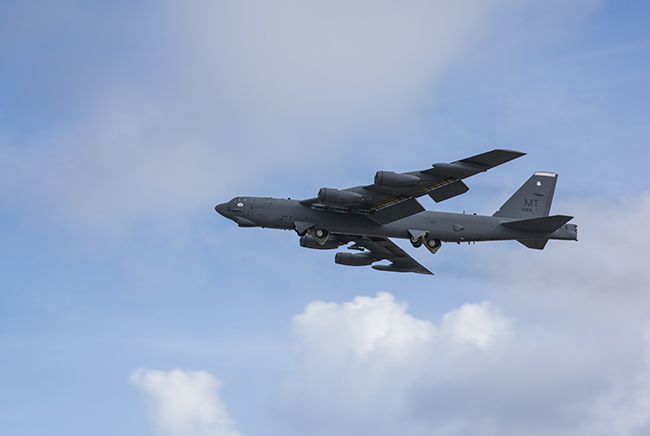
A B-52 Stratofortress from the 23rd Expeditionary Bomber Squadron takes off as part of an Aerial Mining Exercise, April 16, 2019, at Andersen AFB, Guam. Air Force photo by A1C Zachary Heal.
The Air Force’s continuous bomber presence in the Pacific will continue to rely on the venerable B-52 for the foreseeable future as Air Force Global Strike Command wrestles with improving the readiness of the B-1B.
Since 2004, the Air Force has kept bombers stationed at Andersen AFB, Guam, with the B-52s and B-1s rotating through the area, with B-2s occasionally deploying for short periods of time.
For the past couple of years, B-52s have been the mainstay at Andersen as AFGSC pulled B-1s back from deployments after flying hard in the Middle East for years at a pace that “broke” the jets, AFGSC boss Gen. Timothy Ray said.
“We’re very deep into the analysis of the aftermath of flying the B-1 with the wings forward, heavy weights and medium-altitude turns—that’s not how it was built to fly, and it wasn’t built to do it for that long,” Ray told reporters Sept. 18 at AFA’s Air, Space & Cyber Conference. “So when we go through the analysis of what it’s going to take [on in the future], we have some deeper engineering work to do.”
On B-1 ejection seat problems that drove a nearly four-week stand-down earlier this year, Ray said a thorough scrub of the issue revealed no fleet-wide concerns. “Maybe some small training issues, or maybe a broken little piece here, but nothing that put anybody in danger,” he said.
Full-scale fatigue testing turned up a dozen issues that Global Strike worried might affect the entire B-1 fleet of about 60 airframes, he added. In reality, only two of those problems affect a portion of the bombers, and the command expects to work through those maintenance orders by the end of October.
“We’re expecting a near-normal flying pace to begin after that,” Ray said. “The maintainers have been working very hard to take advantage of that downtime, really beef up their training and really look at some of the delayed issues. For instance, at Dyess [AFB, Texas], on that fleet, there [were] about 1,400 delayed discrepancies There are now 400 and decreasing.”
Air Force Magazine reported in July that only six B-1s are fully mission-capable. Ray said that mission-capable rates change every hour, but that AFGSC has about 40 percent of Lancers in its possession.
“We have enough airplanes to fly, we just don’t have enough to fly at the rate we want,” he said. “We are not flying the same duration, so when we looked at the aircraft [at] home, and we looked at the six airplanes forward, the numbers of hours on the six almost match the rest of the fleet.”
Eventually, B-1s will start to return to the Pacific, but in smaller, and shorter, bomber task force deployments as opposed to a full CBP deployment, which typically lasts about six months.
Until then, Brig. Gen. Gentry Boswell, commander of the 36th Wing at Andersen, said Sept. 16 that B-52s will “continue to be the force provider” for continuous bomber presence. The 69th Expeditionary Bomb Squadron from Minot AFB, N.D., is currently deployed, with the 20th Bomb Squadron from Barksdale AFB, La., expected to replace them early next year.
US Indo-Pacific Command has not yet determined the schedule on which B-1s will start to integrate back into the Pacific, Boswell said.
Ray told reporters that Global Strike hopes to see “practice task force movements” in the spring to validate that the B-1s can handle that mission. The command wants to get six or seven months of good flying in by June 2020 to have a sufficient idea of how the B-1 fleet responds holds up.
As those flights ramp up, AFGSC will also continue discussions about how to turn the bomber fleet toward longer-range missions rather than close air support. The debate over whether bombers should handle CAS is “clearly closed,” Ray said, and it’s important to consider what’s next.
“We’ve got to move from being the roving linebacker of the Middle Euphrates River Valley and [Regional Command North in Afghanistan] to being the roving linebacker of the North Atlantic and the Pacific—[Long-Range Anti-Ship Missile, Joint Air-to-Surface Standoff Missile], hypersonics—and so we’re taking a very close look at how we might make that adjustment here very soon,” he said.